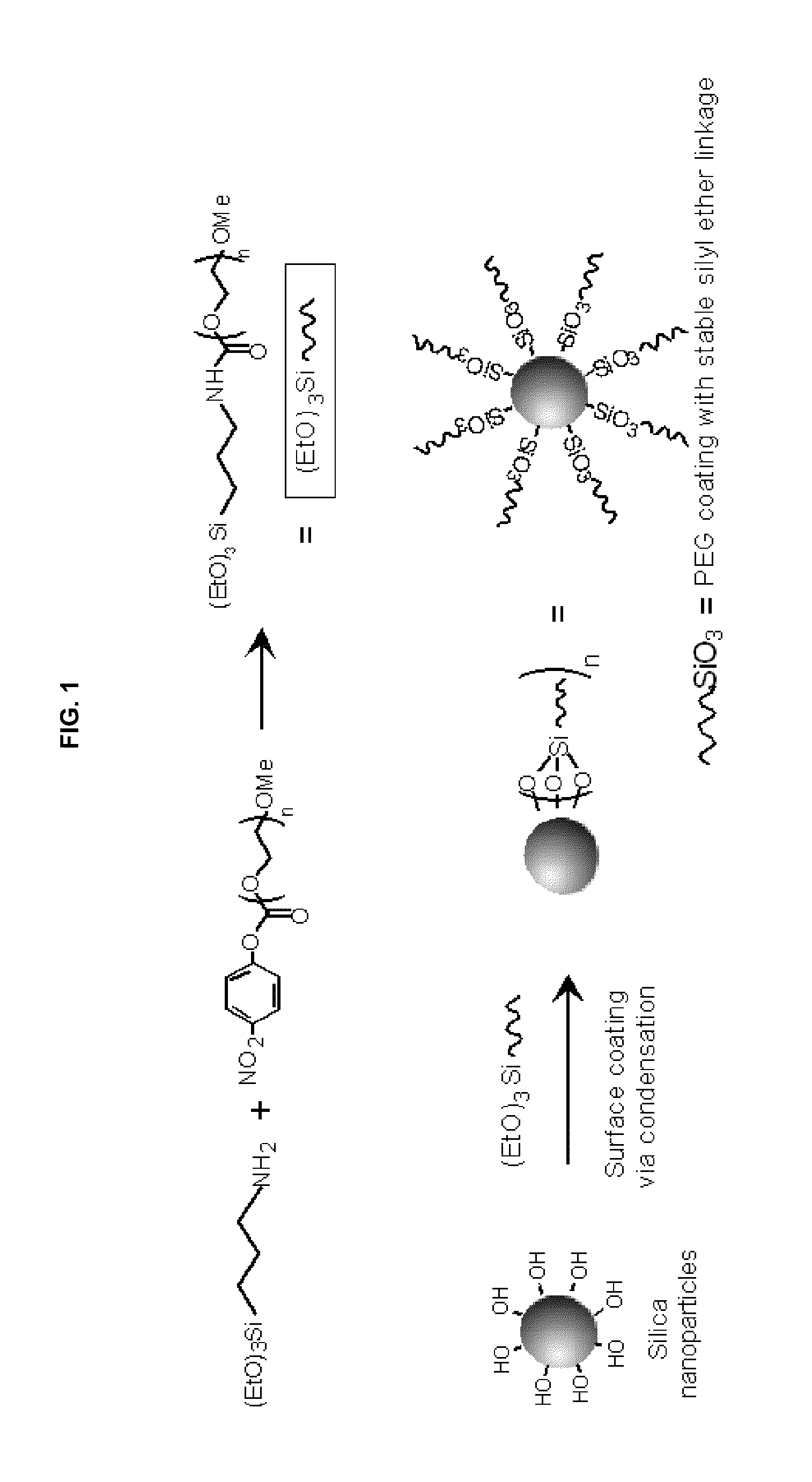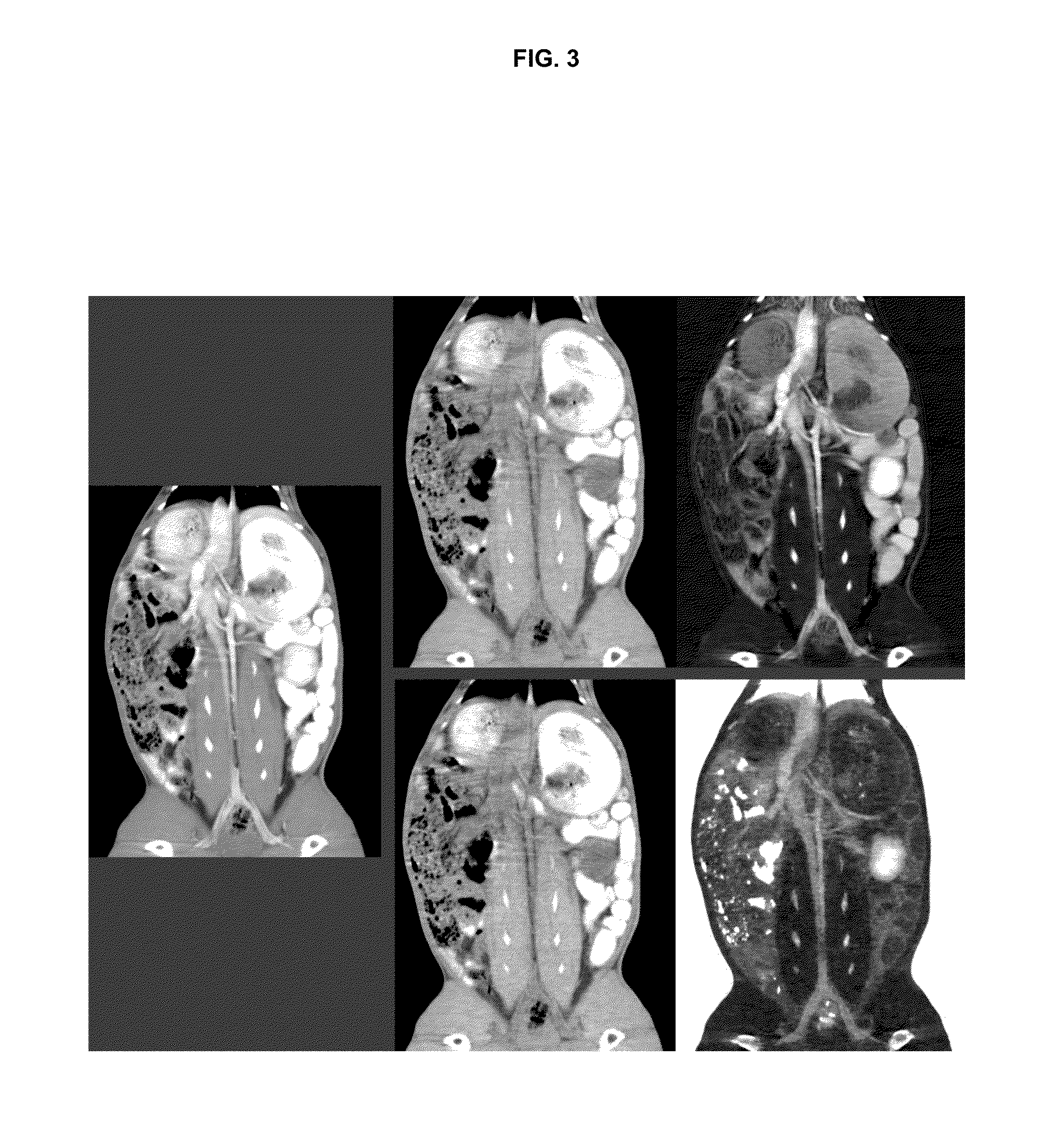Enteric ct contrast material based on low-z atoms
a contrast material and low-z atom technology, applied in tomography, diagnostic recording/measuring, application, etc., can solve the problem of obscuring active intraluminal gastrointestinal bleeding, and achieve the effects of superior evaluation of bowel wall thickening, safe and effective, and superior identification
- Summary
- Abstract
- Description
- Claims
- Application Information
AI Technical Summary
Benefits of technology
Problems solved by technology
Method used
Image
Examples
example 1
Silica Based Agents
[0133]The development of silica based contrast material started from commercially available SiO2 particles including colloid nanoparticle materials (100-200 nm particle size), e.g. LUDOX or SYTON formulations at concentrations as high as 50 wt % of SiO2 (Sigma-Aldrich Inc), which has a CT number of 670-520 HU at 80-140 kVp (CT scanner tube voltage), and a distinguishable 80:140 kVp CT number ratio of ˜1.3 compared to iodinated contrast (80:140 kVp CT number ratio of ˜1.7). These materials are highly stable at pH 9-10 as received, but were found to cross-link to become hard gels within one hour (pH 5.0) or within several hours (pH 7.0) after the pH is changed to the range of 2 to 7 (See, Iler R K. The chemistry of silica: solubility, polymerization, colloid, and surface properties and biochemistry. John Wiley & Sons, 1979, p 366). Use of a pH buffer like 50 mM carbonate buffer (pH 9.0) can apparently prevent the gelling but may not be able to reliably eliminate thi...
example 2
High-Concentration Mg(OH)2 Particulate Formulation
[0157]Common magnesium-containing over the counter medications include Mg(OH)2 which is a good choice as a low-Z contrast material platform, but the available over the counter medication concentrations are too low (in the range of tens milligrams of Mg per mL) for effective use as CT contrast material. High-concentration Mg-based formulations are therefore needed. One example is a high-concentration Mg(OH)2 suspension, which was successfully tested in a rabbit model without observing obvious toxicity or discomfort, probably due to its low solubility in water. The Mg(OH)2 was diluted as a 400-HU homogeneous suspension from an originally 60 wt % suspension (namely, 60 g magnesium hydroxide in 100 g of formulated homogeneous suspension which was obtained commercially and measured ˜700 HU at 80 kVp at CT). The benefit of Mg(OH)2 microparticles is that dissolution is slow, and so systemic exposure to Mg is low. Furthermore, absorbed Mg is...
example 3
[0159]A computer simulation demonstrated that contrast agents containing atoms with a high (Z=70 to 82) or low (Z<25) atomic number as the reporter atom can theoretically be outstanding complements to iodine- or barium- (Z=53 and 56, respectively) based contrast agents. Notably, the only currently clinically available CT contrast materials utilize iodine or barium as the reporter atom. Contrast agents with these high or low atomic number reporter atoms show markedly different CT X-ray number ratios for low and high kVp settings compared to iodine- or barium-based contrast material. Iodine- and barium-based contrast materials show an 80:140 kVp CT number ratio (“80:140 kVp ratio”) of approximately 1.75. The high and low atomic number agents should show 80:140 kVp ratios of <1.35. Notably, the 80:140 kVp ratio of water is by definition 1.0. Iodine- and barium-based contrast materials have the highest theoretical 80:140 kVp ratios of the elements on the periodic table. Of note: for con...
PUM
 Login to View More
Login to View More Abstract
Description
Claims
Application Information
 Login to View More
Login to View More - R&D
- Intellectual Property
- Life Sciences
- Materials
- Tech Scout
- Unparalleled Data Quality
- Higher Quality Content
- 60% Fewer Hallucinations
Browse by: Latest US Patents, China's latest patents, Technical Efficacy Thesaurus, Application Domain, Technology Topic, Popular Technical Reports.
© 2025 PatSnap. All rights reserved.Legal|Privacy policy|Modern Slavery Act Transparency Statement|Sitemap|About US| Contact US: help@patsnap.com



